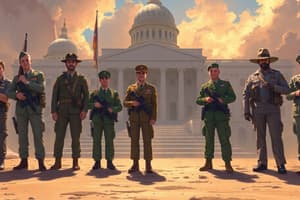Podcast
Questions and Answers
What was the primary purpose of the Committee on Public Information?
What was the primary purpose of the Committee on Public Information?
- To promote industrial growth
- To regulate trade
- To establish laws for immigration
- To influence public opinion regarding World War I (correct)
Who established the Committee on Public Information?
Who established the Committee on Public Information?
Woodrow Wilson
What was the National Recovery Administration (NRA) established to do?
What was the National Recovery Administration (NRA) established to do?
- Support agricultural practices
- Regulate immigration
- Increase military funding
- Eliminate cut-throat competition (correct)
The National Recovery Administration was declared unconstitutional by the U.S. Supreme Court.
The National Recovery Administration was declared unconstitutional by the U.S. Supreme Court.
What was the Great Migration?
What was the Great Migration?
What characterized trench warfare?
What characterized trench warfare?
What was the maximum percentage of immigrants allowed by the Immigration Act of 1924 from any country?
What was the maximum percentage of immigrants allowed by the Immigration Act of 1924 from any country?
Flappers in the 1920s were notable for their conservative fashion choices.
Flappers in the 1920s were notable for their conservative fashion choices.
What general behavior was associated with flappers in the 1920s?
What general behavior was associated with flappers in the 1920s?
Flashcards are hidden until you start studying
Study Notes
Committee on Public Information
- Established by President Woodrow Wilson on April 13, 1917, through Executive Order 2594.
- Aimed to influence public opinion on U.S. involvement in World War I.
- Headed by George Creel, alongside Secretaries of State, War, and Navy.
- Operated for 28 months (April 1917 - August 1919) using various media to garner support for the war.
National Recovery Administration
- Created in 1933 as part of Franklin D. Roosevelt's New Deal to eliminate intense competition.
- Brought together industry, labor, and government to establish codes of fair practices.
- Aimed to set minimum wages, maximum hours, and stabilize prices.
- Deemed unconstitutional by the Supreme Court in 1935, leading to a halt in operations.
Great Black Migration
- Spanning from 1910 to 1930, approximately 2 million African Americans moved from the Southern U.S. to urban areas in the Midwest, Northeast, and West.
- Motivated by the escape from racism and the pursuit of job opportunities in industrial cities.
- Historians identify a First Great Migration (1910-1940) and a Second (1940-1970) with over 5 million migrants during the latter.
- By 1970, more than 80% of African Americans lived in cities, with notable demographics across different regions.
Trench Warfare
- Characterized by defensive positions occupied by combatants, providing immunity from small arms fire.
- Emerged during World War I due to advances in weapon firepower without matched mobility tactics.
- Featured extensive networks of trenches, barbed wire, and a hazardous "no man's land."
- Attacks often resulted in high casualties despite occasional tactical successes.
Immigration Act of 1924
- Also known as the Johnson-Reed Act, it aimed to further restrict immigration based on national origins.
- Limited admissions to 2% of the number of immigrants from each country present in the U.S. as of 1890.
- Specifically targeted Southern and Eastern European immigrants and effectively excluded East Asians and Asian Indians.
- Minimal opposition existed in Congress during its passage.
Flapper
- Refers to a new generation of young women in the 1920s who challenged traditional norms.
- Defined by short skirts, bobbed hair, and a fondness for jazz music.
- Notable for their bold behavior, including the flaunting of makeup and increased social liberties.
Studying That Suits You
Use AI to generate personalized quizzes and flashcards to suit your learning preferences.





